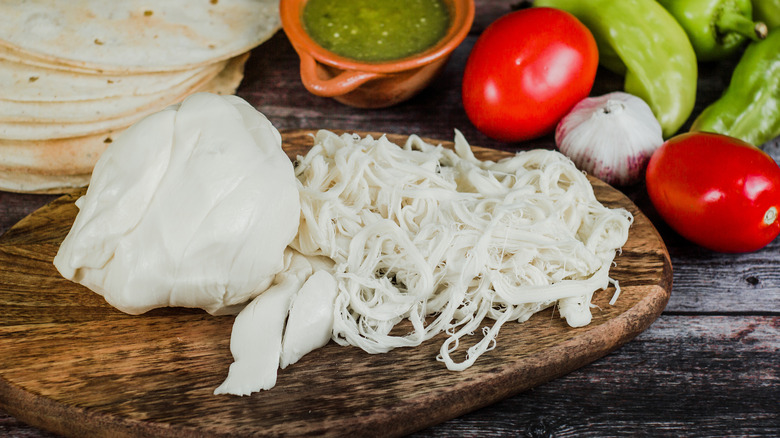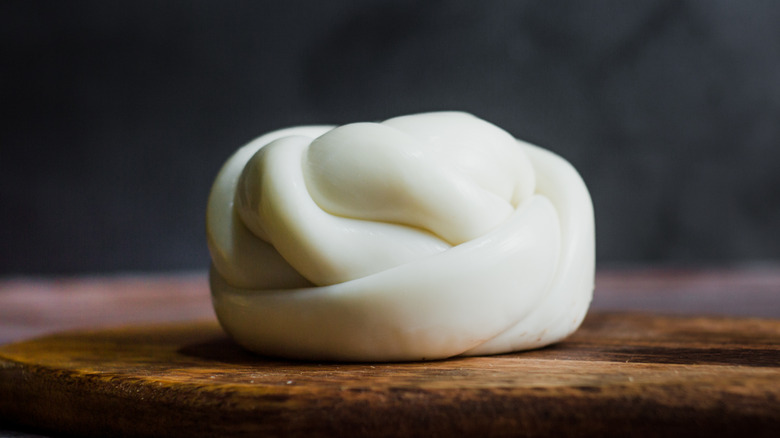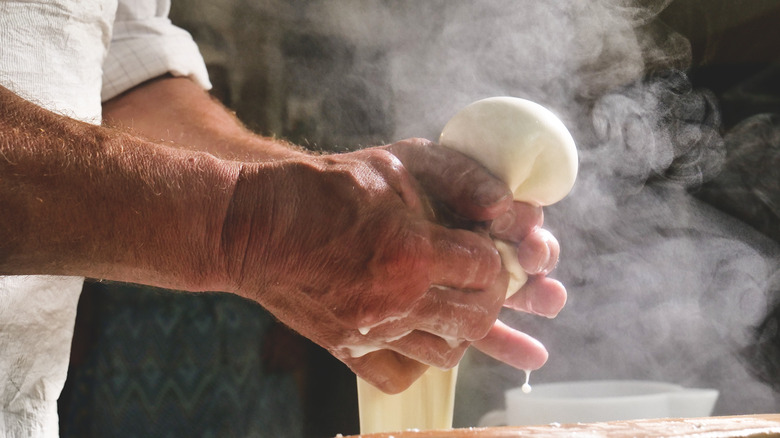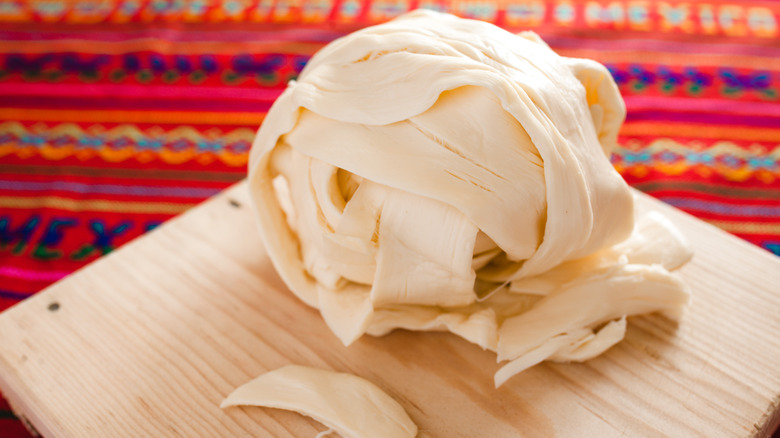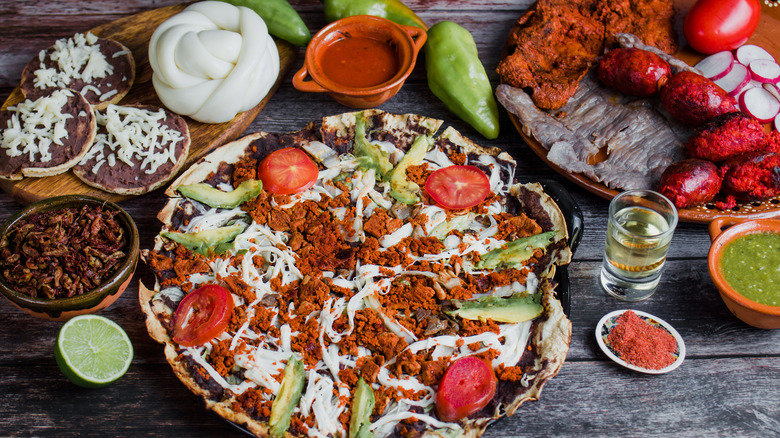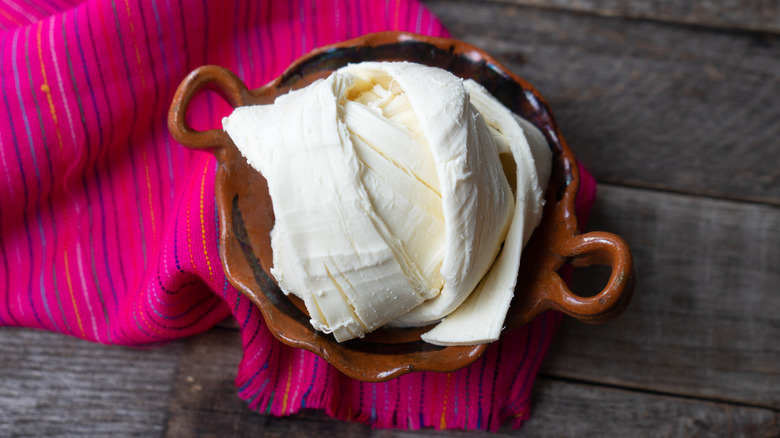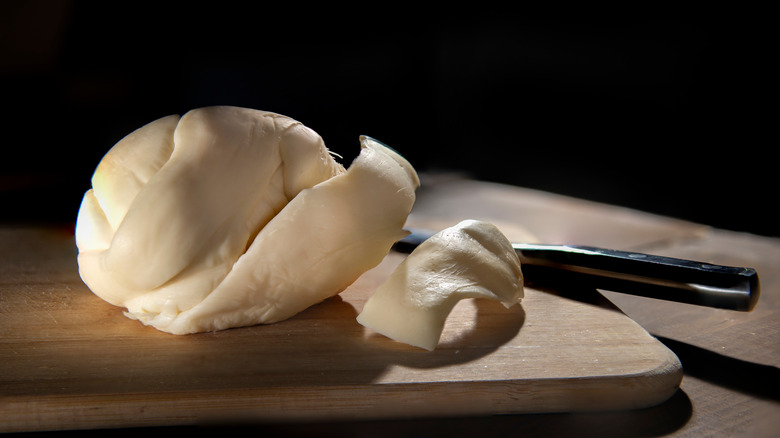Why Mexico's Stretchy Oaxaca Cheese Stands Out From The Rest
If you've ever visited the southwestern state of Oaxaca, Mexico (pronounced wah-HAH-kuh), then you've undoubtedly sunk your teeth into the milky, stretchy, mozzarella-like cheese that shows up in so many of the dishes and antojitos — the "little cravings" snacks sold at street stalls and casual restaurants — of the region. Called queso Oaxaca or Oaxaca cheese throughout the country of Mexico and abroad, but known simply as quesillo in its home state (via Oaxaca Life), Oaxaca cheese is a stretchy, rubbery type of string cheese made from cow's milk (via Taste of Home). Formed into a sort of long, flat rope when it's made, the cheese is then wrapped around itself like yarn and is sold in distinctive balls, which, at home, must be unwound in order to utilize the cheese. A beloved and essential ingredient in its home state, Oaxaca cheese has gone on to show up in dishes across Mexico and around the world.
What is Oaxaca cheese?
Believed to have originally been created in the southwestern state of Oaxaca, Mexico, the milky, stretchy cow's milk cheese is extremely similar to mozzarella. Boasting a mild flavor and a texture that melts extremely well when heated, Oaxaca cheese's similarity to mozzarella is no accident; it's believed that the process for making the cheese was introduced to the region by Spanish Dominicans, a Roman Catholic order that began to settle in the region starting in the early 1500s in an effort to convert the local indigenous populations (via World History Connected).
According to Taste of Home, Dominican monks who would have been familiar with the Italian tradition of buffalo milk mozzarella switched to using locally available cow's milk, and Oaxaca cheese was born. White or off-white in color, the mozzarella-like cheese grew in popularity over time, both with the area's colonizers as well as with local residents.
How is Oaxaca cheese made?
Like mozzarella, Taste of Home notes, Oaxaca cheese is a "pasta filata" type cheese, a stretched-curd or spun paste cheese made by submerging hot curds in water and stretching them by hand or with a machine before forming the cheese into its final shape (via Cheese Science Toolkit). These cheeses are typically stretchy in nature and melt extremely well.
The Oaxaca cheese-making process is very similar to that of making mozzarella, according to the New England Cheesemaking Supply Company. Taste of Home explains that first rennet is added to gently heated whole milk, separating the curds, or solids, from the whey, or liquid. Once set and drained of the whey, the curds are cut into smaller portions, submerged in hot water to soften them, then kneaded and stretched long and thin to make the stringy, flat, pill-apart ropes distinctive to the cheese. At this stage, the flat ropes are wound into the distinctive balls of Oaxaca cheese, then briefly soaked in brine in order to add salt to the cheese.
What does Oaxaca cheese taste like?
According to The Spruce Eats, Oaxaca cheese tastes milky and mild, with a slight saltiness from the brine the cheese sits in briefly before being sold. The cheese shares many similarities with mozzarella, having a firm, rubbery texture that melts extremely well, becoming gooey and stretchy. Oaxaca cheese is also similar to what we call string cheese, its ropy strands easily pulling apart for easier piling onto sandwiches, into quesadillas, or simply piling onto a plate with other garnishes such as sliced avocado, pickled jalapeños, and crunchy tostadas to enjoy as a botana, or little snack or appetizer (via Real de Oaxaca).
As noted by Soy Oaxaca, there's also a richer, meltier, more expensive version of queso Oaxaca that's called doble crema or double cream. This version adds an extra quantity of cheese curds and milk solids to the cheese base, resulting in a thicker and more robust cheese that's perfect for eating on its own, where the milkier flavor will truly stand out.
How to cook with queso Oaxaca
If you've ever enjoyed a quesadilla, chile relleno, torta, or any other typically Mexican dish that features stretchy melted cheese, then you've already dug into Oaxaca cheese. This cheese with its wonderful melting texture is used in a huge variety of Mexican dishes, according to The Spruce Eats, from the loaded sandwiches known as tortas or cemitas to simply gridded quesadillas or empanadas to chiles rellenos, those battered-and-deep-fried poblano peppers that are often first stuffed with cheese.
You could employ Oaxaca cheese when making your own versions of these dishes at home, but it's also handy to know that Oaxaca cheese and mozzarella can be used interchangeably. So if you're craving a loaded pork torta and don't have any queso Oaxaca on hand, feel free to sub in whole milk mozzarella instead; likewise, if pizza is on the menu and you happen to have extra Oaxaca cheese on hand, you can grate it and use it as you would good ol' mozz.
Where to buy Oaxaca cheese
Having become one of Mexico's most famous cheeses over the past few centuries, according to Matador Network, lots of Oaxaca cheese is exported to the United States and is readily available in areas that have a large Hispanic population. Makers such as Real de Oaxaca, Cacique, FUD, and El Mexicano supply Oaxaca cheese to a variety of Mexican and Latin American specialty food stores, and in some areas can even be found in large chains such as Walmart and Whole Foods. Look for the cheese in your grocer's refrigerator case, where it will likely be stocked near other Mexican cheeses such as cotija and queso fresco.
Store Oaxaca cheese in the refrigerator, and after opening it transfer it to a plastic bag or airtight container (via The Spruce Eats). The cheese should last for up to a week. If you choose to freeze the cheese, wrap it tightly in plastic wrap before freezing for up to three months, and know that post-thawing it will no longer be tasty for enjoying as-is but will still melt fantastically into dishes.
Oaxaca cheese nutritional information
Although it's most often made with whole cow's milk, Oaxaca cheese can also be made with part skim milk or come in the richer, fattier doble crema variety. A standard whole milk style will contain about 8 grams of fat, 6 grams of protein, and 100 calories per 1-ounce serving, along with 10 milligrams of cholesterol, 250 milligrams of sodium (about 10% of the daily recommended intake), and a gram of sugar in the form of lactose (via Kroger).
Part-skim varieties of Oaxaca cheese will contain slightly less fat and fewer calories per serving: 6 grams, and 80 calories, respectively (via Cacique Foods). If you can get your hands on the richer double-cream variety of queso Oaxaca (via Soy Oaxaca), expect a bit more fat and calories per serving than are present in the whole milk variety.
Whichever type of Oaxaca cheese you choose, your homemade plates of Mexican food are about to get cheesier, meltier, and more authentic.
